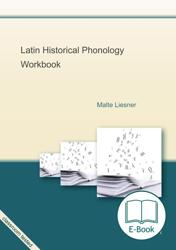This book has been designed for students of Latin and Indo-European-Linguistics and can be used for university-courses or self-study in order to learn the complex issues of Latin historical phonology within a short time. The implemented one-step-method allows the user to understand in detail every step of a derivation which leads from an Indo-European pre-form to a Latin word because in each step of the derivation a number refers to a complete list of Latin sound laws. The user can complete missing word forms in over 1000 gaps of phonological derivations. Answers to all the exercises are included in the book.
This book has been designed for students of Latin and Indo-European-Linguistics and can be used for university courses or self study in order to learn the complex issues of Latin historical phonology within a short time. The implemented one-step-method allows the user to understand in detail every step of a derivation which leads from an Indo-European preform to a Latin word because in each step of the derivation a number refers to a complete list of Latin sound laws. The user can complete missing word forms in over 1000 gaps of phonological derivations.
In each teaching unit the left page contains the explanations and descriptions of Latin sound laws and the right page offers exercises to train the learning matter. Sound laws, which are explained in other units, are additionally given on the exercise pages. Answers to all the exercises are included in the book. The comprehensive index includes all Latin sound laws and is referred to in every step of a phonological derivation as well as in all the explanations. The index can be used for reference as well. Consideration is taken that all explanations firstly use Latin data for reconstruction and other languages only where needed.
In the chapters about linguistic fundamentals the basic principles of Latin linguistics are introduced which are the analysis of phonemes, accentuation and syllabification as well as the modelling of diachronic sound change. The following chapters present the evolution of Latin vowels and focuses on vowel lengthening and shortening, vowel contraction, vowel weakening in interior syllables and the Latin monophthongizations.
The next chapters present in detail the transformations of Latin consonants such as assimilations, dissimilations, the simplification of geminated consonants and the loss of consonants in initial, medial or final position. After the following chapter about analogical changes, the book focuses on the evolution of the Indo-European sound system to the Latin sound system and presents the transformations of Labiovelars, Laryngeals, Media Aspirata and syllabic resonants. A comprehensive chapter about reconstruction inaugurates the beginner with the principles of historic linguistic reconstruction.
The numeric index presents all discussed sound laws and is a great source for quick information. All the important data can be seen at a glance. The appendix offers tables about the chronology of the sound laws, characteristic features of Latin languages epochs as well as an overview of the Indo-European languages.
Malte Liesner works as a Latin lecturer at the University of Bamberg and as a teacher of Business English in companies and educational institutions. He studied Indo-European Languages, Indology and Computational Linguistics at the Universities of Cologne and Würzburg in Germany.


 Preface
Preface